Analysis of Online Shopping Behavior: A Statistics Assignment
VerifiedAdded on 2023/01/23
|9
|1642
|53
Homework Assignment
AI Summary
This statistics assignment investigates online shopping behavior, aiming to determine relationships between time spent on a website and spending, as well as the influence of age and attitude. The study employed simple random sampling and utilized SPSS for data analysis, including descriptive and inferential statistics like Pearson correlation and t-tests. The findings revealed no significant correlation between time spent and amount spent, nor between attitude and spending. However, a significant positive correlation was found between age and spending. Furthermore, the study found no significant difference in attitude between genders. The assignment includes hypothesis testing, summary statistics, and detailed results tables, along with relevant references. The student analyzes correlations, compares means, and interprets statistical significance to draw conclusions about online shopping habits.
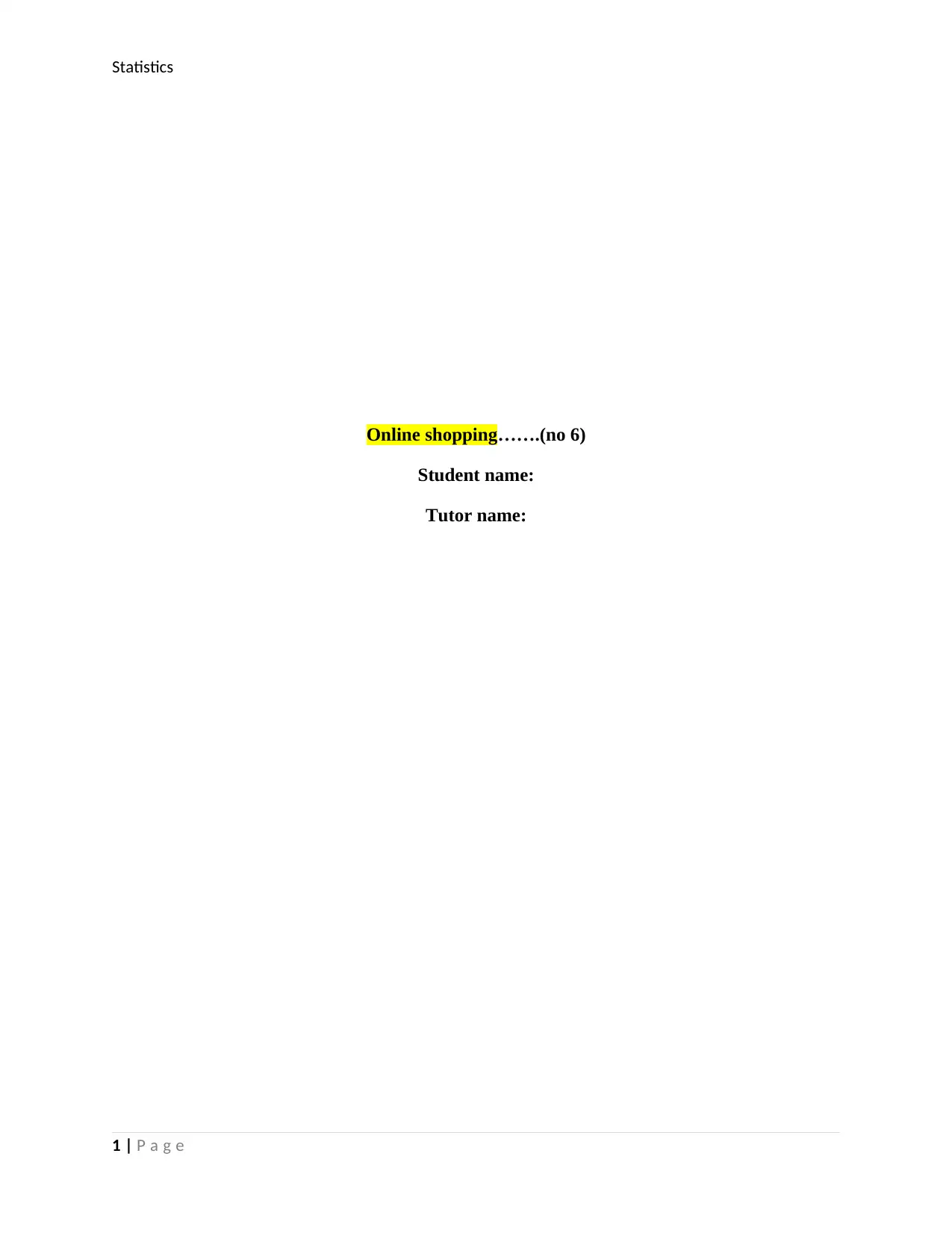
Statistics
Online shopping…….(no 6)
Student name:
Tutor name:
1 | P a g e
Online shopping…….(no 6)
Student name:
Tutor name:
1 | P a g e
Paraphrase This Document
Need a fresh take? Get an instant paraphrase of this document with our AI Paraphraser
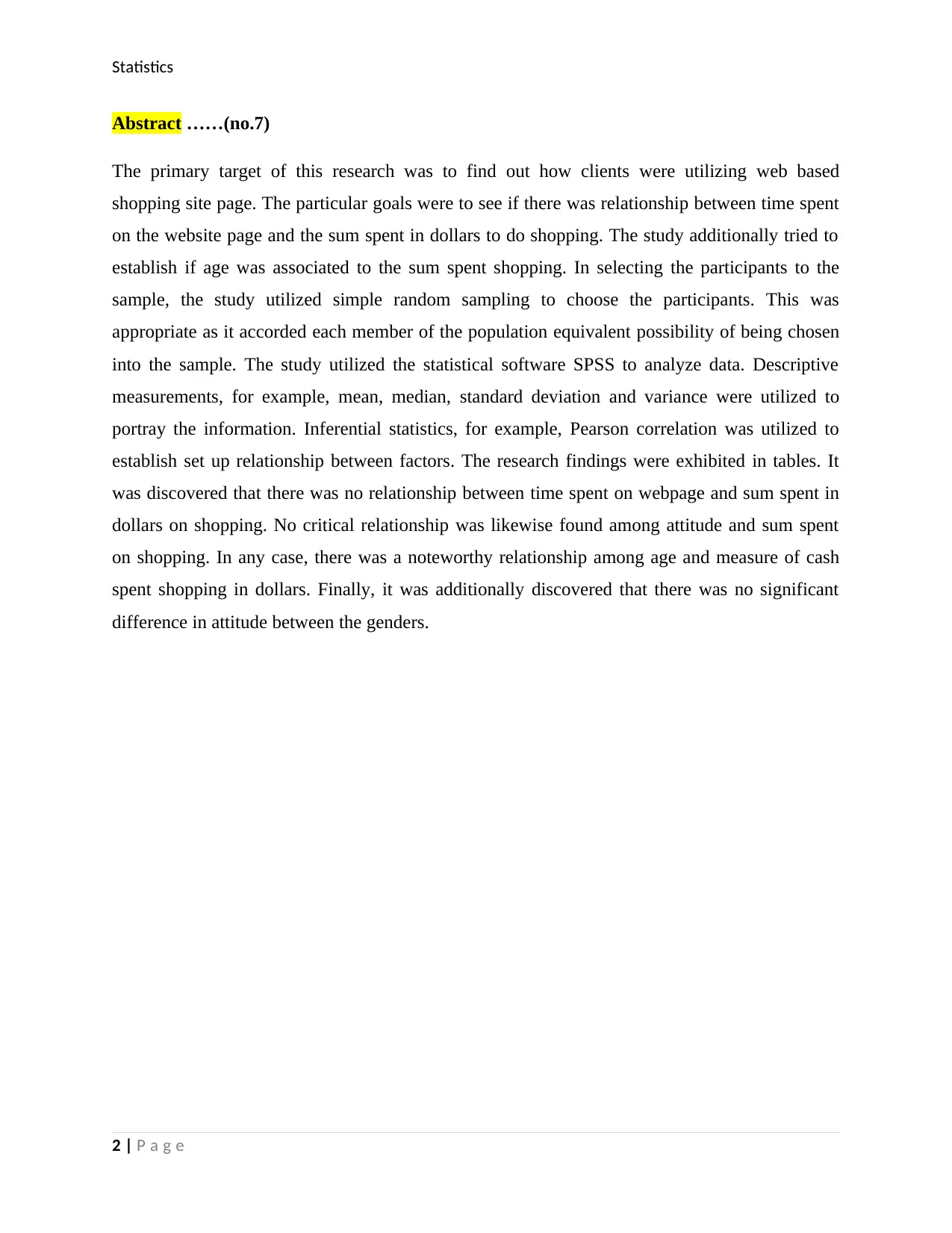
Statistics
Abstract ……(no.7)
The primary target of this research was to find out how clients were utilizing web based
shopping site page. The particular goals were to see if there was relationship between time spent
on the website page and the sum spent in dollars to do shopping. The study additionally tried to
establish if age was associated to the sum spent shopping. In selecting the participants to the
sample, the study utilized simple random sampling to choose the participants. This was
appropriate as it accorded each member of the population equivalent possibility of being chosen
into the sample. The study utilized the statistical software SPSS to analyze data. Descriptive
measurements, for example, mean, median, standard deviation and variance were utilized to
portray the information. Inferential statistics, for example, Pearson correlation was utilized to
establish set up relationship between factors. The research findings were exhibited in tables. It
was discovered that there was no relationship between time spent on webpage and sum spent in
dollars on shopping. No critical relationship was likewise found among attitude and sum spent
on shopping. In any case, there was a noteworthy relationship among age and measure of cash
spent shopping in dollars. Finally, it was additionally discovered that there was no significant
difference in attitude between the genders.
2 | P a g e
Abstract ……(no.7)
The primary target of this research was to find out how clients were utilizing web based
shopping site page. The particular goals were to see if there was relationship between time spent
on the website page and the sum spent in dollars to do shopping. The study additionally tried to
establish if age was associated to the sum spent shopping. In selecting the participants to the
sample, the study utilized simple random sampling to choose the participants. This was
appropriate as it accorded each member of the population equivalent possibility of being chosen
into the sample. The study utilized the statistical software SPSS to analyze data. Descriptive
measurements, for example, mean, median, standard deviation and variance were utilized to
portray the information. Inferential statistics, for example, Pearson correlation was utilized to
establish set up relationship between factors. The research findings were exhibited in tables. It
was discovered that there was no relationship between time spent on webpage and sum spent in
dollars on shopping. No critical relationship was likewise found among attitude and sum spent
on shopping. In any case, there was a noteworthy relationship among age and measure of cash
spent shopping in dollars. Finally, it was additionally discovered that there was no significant
difference in attitude between the genders.
2 | P a g e

Statistics
Introduction
The primary target of this research was to find out how clients were utilizing web based
shopping site page. The particular goals were to see if there was relationship between time spent
on the website page and the sum spent in dollars to do shopping. The study additionally tried to
establish if age was associated to the sum spent shopping.
Sampling …….(no. 8)
To select a sample that was not going to encourage biasness, the research study utilized two
sampling techniques. The first technique to be employed was purposive sampling then the
second technique was random sampling. Purposive sampling was used to choose a pool of
respondents who have dependably visited the website page for internet shopping. This was done
to guarantee that the general population who had not visited the website page does not get into
the sample. After a pool of respondents had been chosen, the study used random sampling testing
to choose a sample of 50 respondents. This technique was embraced as it enabled each member
in the pool to have an equal chance of being chosen in the sample (Hicks, 2013). It likewise
eliminated biasness that may have emerged because of human mistake. It was additionally
simpler on the research team since it required less investment and assets to facilitate the
procedure (Fleiss and Paik, 2003). This proved to be useful as there was limitation of time.
Methodology………(no. 9)
The study utilized the statistical software SPSS to analyze data. Descriptive measurements, for
example, mean, median, standard deviation and variance were utilized to portray the information.
Inferential statistics, for example, Pearson correlation was utilized to establish set up relationship
between factors (Bhattacharyya & Johnson , 2013). The research findings were exhibited in
tables.
3 | P a g e
Introduction
The primary target of this research was to find out how clients were utilizing web based
shopping site page. The particular goals were to see if there was relationship between time spent
on the website page and the sum spent in dollars to do shopping. The study additionally tried to
establish if age was associated to the sum spent shopping.
Sampling …….(no. 8)
To select a sample that was not going to encourage biasness, the research study utilized two
sampling techniques. The first technique to be employed was purposive sampling then the
second technique was random sampling. Purposive sampling was used to choose a pool of
respondents who have dependably visited the website page for internet shopping. This was done
to guarantee that the general population who had not visited the website page does not get into
the sample. After a pool of respondents had been chosen, the study used random sampling testing
to choose a sample of 50 respondents. This technique was embraced as it enabled each member
in the pool to have an equal chance of being chosen in the sample (Hicks, 2013). It likewise
eliminated biasness that may have emerged because of human mistake. It was additionally
simpler on the research team since it required less investment and assets to facilitate the
procedure (Fleiss and Paik, 2003). This proved to be useful as there was limitation of time.
Methodology………(no. 9)
The study utilized the statistical software SPSS to analyze data. Descriptive measurements, for
example, mean, median, standard deviation and variance were utilized to portray the information.
Inferential statistics, for example, Pearson correlation was utilized to establish set up relationship
between factors (Bhattacharyya & Johnson , 2013). The research findings were exhibited in
tables.
3 | P a g e
⊘ This is a preview!⊘
Do you want full access?
Subscribe today to unlock all pages.

Trusted by 1+ million students worldwide
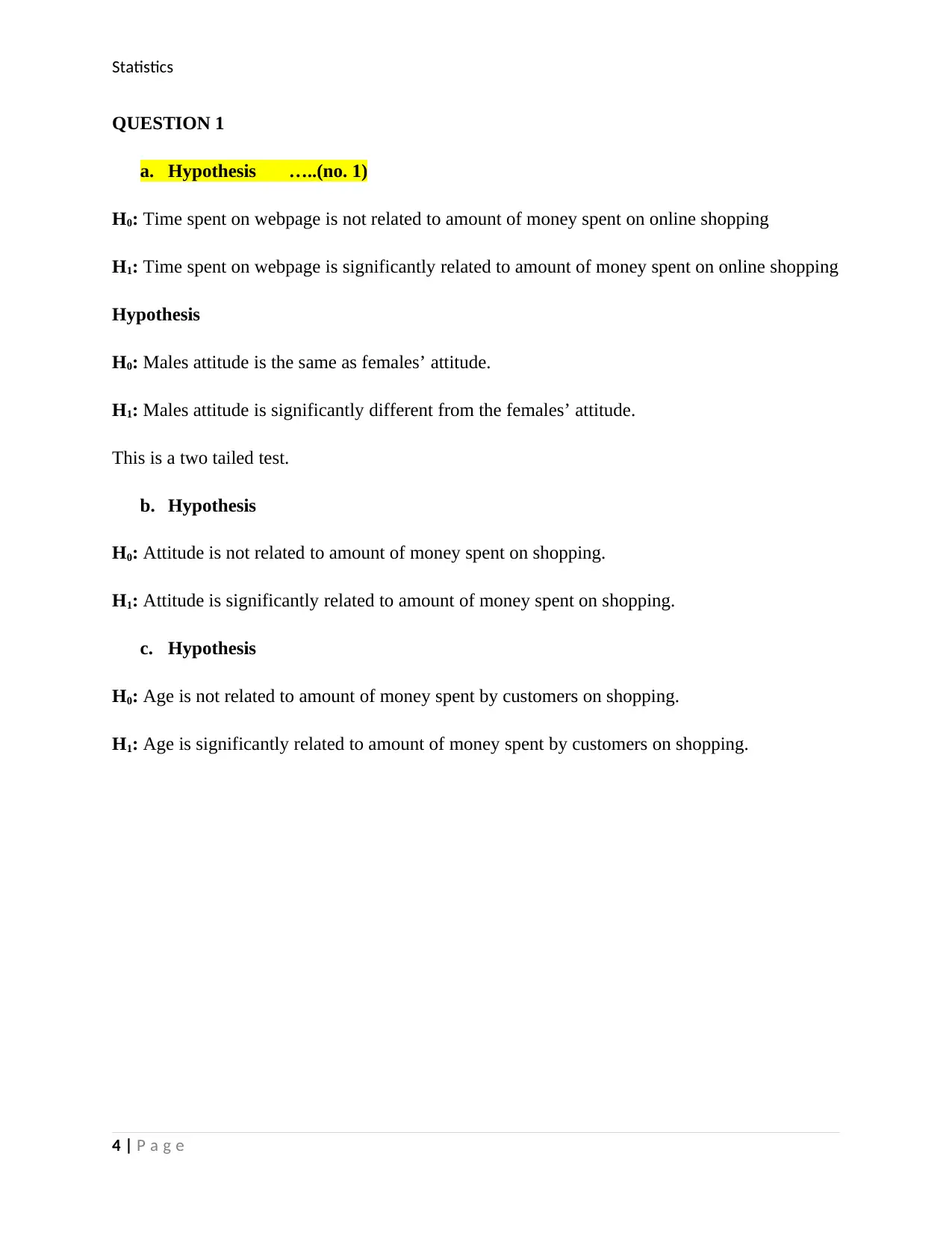
Statistics
QUESTION 1
a. Hypothesis …..(no. 1)
H0: Time spent on webpage is not related to amount of money spent on online shopping
H1: Time spent on webpage is significantly related to amount of money spent on online shopping
Hypothesis
H0: Males attitude is the same as females’ attitude.
H1: Males attitude is significantly different from the females’ attitude.
This is a two tailed test.
b. Hypothesis
H0: Attitude is not related to amount of money spent on shopping.
H1: Attitude is significantly related to amount of money spent on shopping.
c. Hypothesis
H0: Age is not related to amount of money spent by customers on shopping.
H1: Age is significantly related to amount of money spent by customers on shopping.
4 | P a g e
QUESTION 1
a. Hypothesis …..(no. 1)
H0: Time spent on webpage is not related to amount of money spent on online shopping
H1: Time spent on webpage is significantly related to amount of money spent on online shopping
Hypothesis
H0: Males attitude is the same as females’ attitude.
H1: Males attitude is significantly different from the females’ attitude.
This is a two tailed test.
b. Hypothesis
H0: Attitude is not related to amount of money spent on shopping.
H1: Attitude is significantly related to amount of money spent on shopping.
c. Hypothesis
H0: Age is not related to amount of money spent by customers on shopping.
H1: Age is significantly related to amount of money spent by customers on shopping.
4 | P a g e
Paraphrase This Document
Need a fresh take? Get an instant paraphrase of this document with our AI Paraphraser
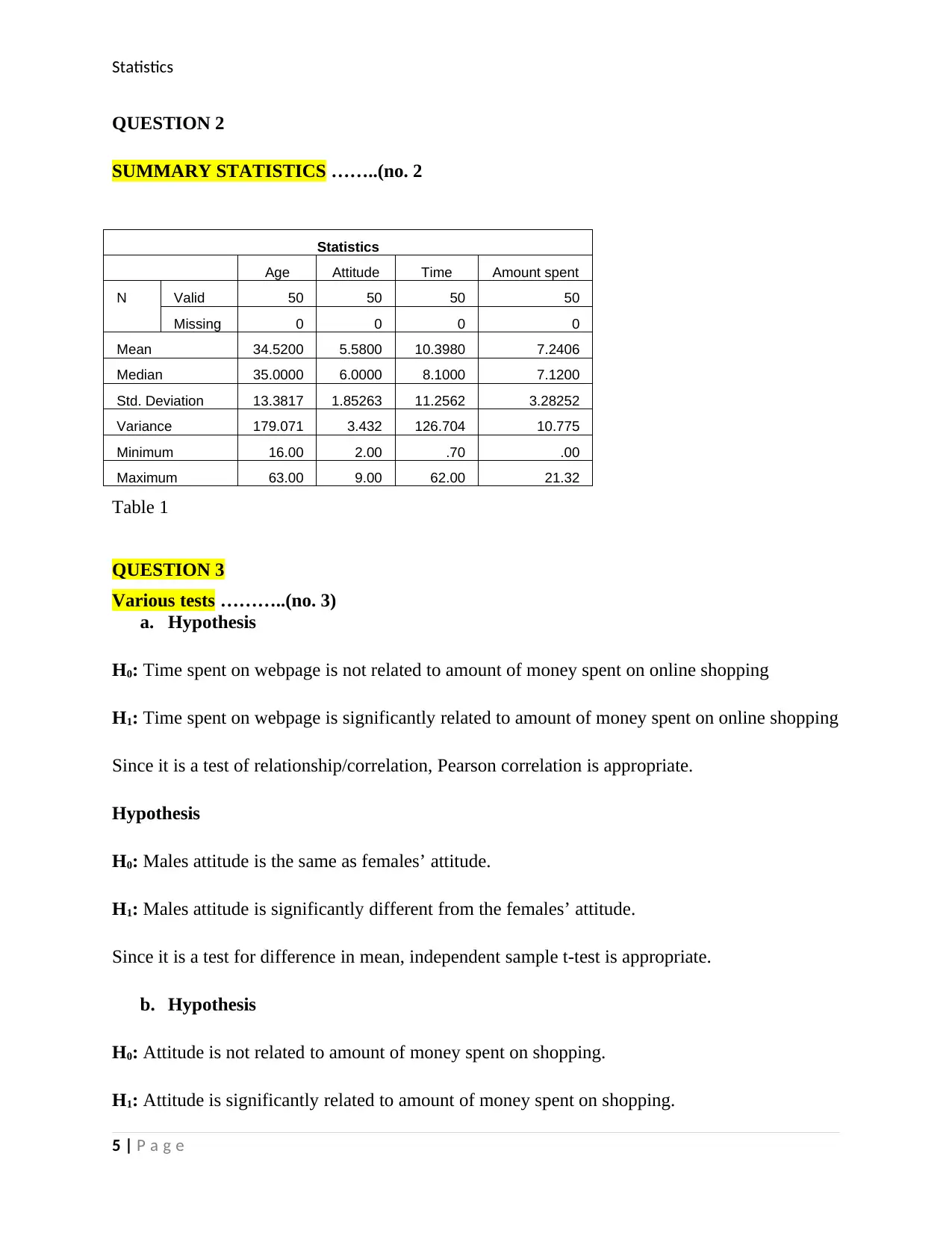
Statistics
QUESTION 2
SUMMARY STATISTICS ……..(no. 2
Statistics
Age Attitude Time Amount spent
N Valid 50 50 50 50
Missing 0 0 0 0
Mean 34.5200 5.5800 10.3980 7.2406
Median 35.0000 6.0000 8.1000 7.1200
Std. Deviation 13.3817 1.85263 11.2562 3.28252
Variance 179.071 3.432 126.704 10.775
Minimum 16.00 2.00 .70 .00
Maximum 63.00 9.00 62.00 21.32
Table 1
QUESTION 3
Various tests ………..(no. 3)
a. Hypothesis
H0: Time spent on webpage is not related to amount of money spent on online shopping
H1: Time spent on webpage is significantly related to amount of money spent on online shopping
Since it is a test of relationship/correlation, Pearson correlation is appropriate.
Hypothesis
H0: Males attitude is the same as females’ attitude.
H1: Males attitude is significantly different from the females’ attitude.
Since it is a test for difference in mean, independent sample t-test is appropriate.
b. Hypothesis
H0: Attitude is not related to amount of money spent on shopping.
H1: Attitude is significantly related to amount of money spent on shopping.
5 | P a g e
QUESTION 2
SUMMARY STATISTICS ……..(no. 2
Statistics
Age Attitude Time Amount spent
N Valid 50 50 50 50
Missing 0 0 0 0
Mean 34.5200 5.5800 10.3980 7.2406
Median 35.0000 6.0000 8.1000 7.1200
Std. Deviation 13.3817 1.85263 11.2562 3.28252
Variance 179.071 3.432 126.704 10.775
Minimum 16.00 2.00 .70 .00
Maximum 63.00 9.00 62.00 21.32
Table 1
QUESTION 3
Various tests ………..(no. 3)
a. Hypothesis
H0: Time spent on webpage is not related to amount of money spent on online shopping
H1: Time spent on webpage is significantly related to amount of money spent on online shopping
Since it is a test of relationship/correlation, Pearson correlation is appropriate.
Hypothesis
H0: Males attitude is the same as females’ attitude.
H1: Males attitude is significantly different from the females’ attitude.
Since it is a test for difference in mean, independent sample t-test is appropriate.
b. Hypothesis
H0: Attitude is not related to amount of money spent on shopping.
H1: Attitude is significantly related to amount of money spent on shopping.
5 | P a g e
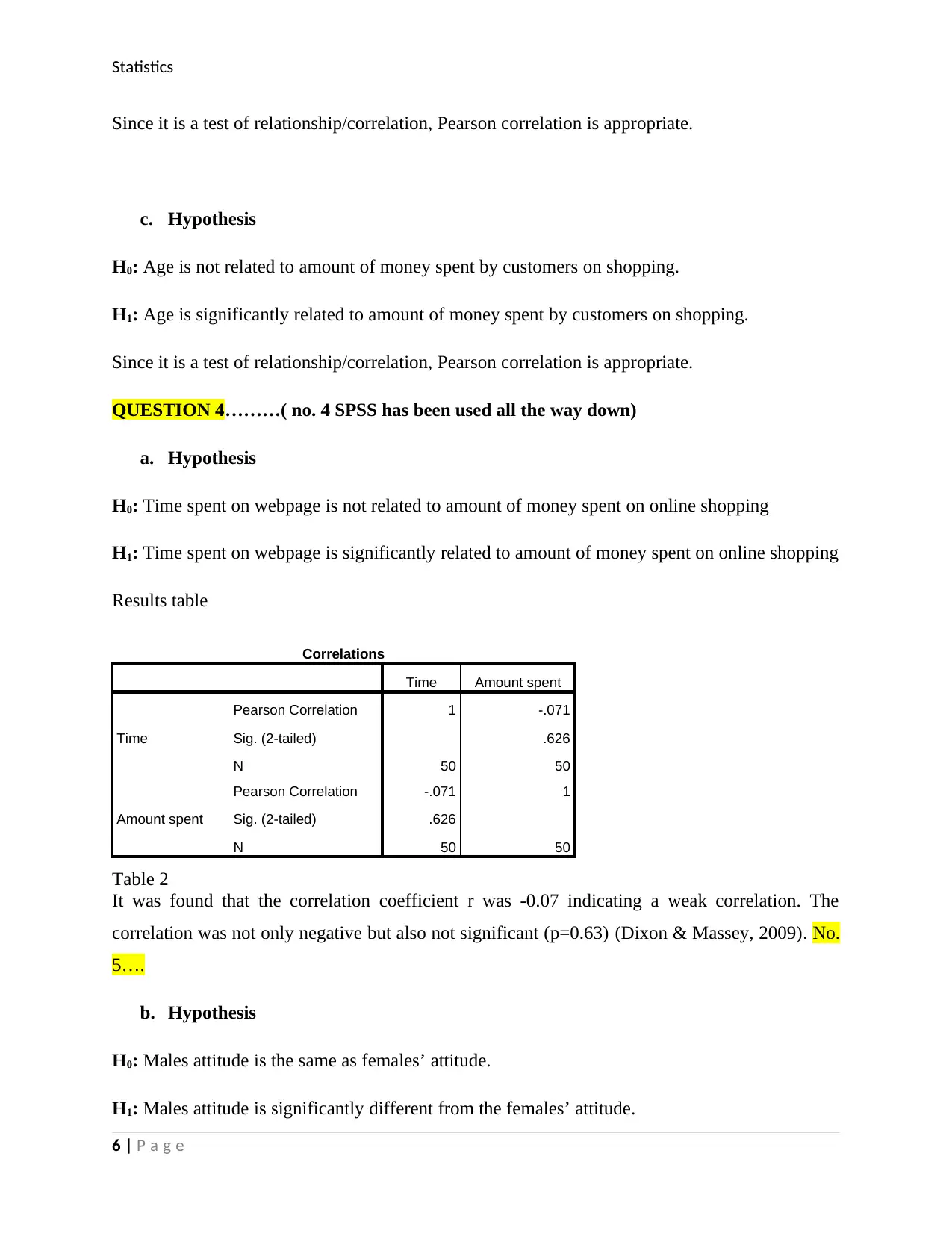
Statistics
Since it is a test of relationship/correlation, Pearson correlation is appropriate.
c. Hypothesis
H0: Age is not related to amount of money spent by customers on shopping.
H1: Age is significantly related to amount of money spent by customers on shopping.
Since it is a test of relationship/correlation, Pearson correlation is appropriate.
QUESTION 4………( no. 4 SPSS has been used all the way down)
a. Hypothesis
H0: Time spent on webpage is not related to amount of money spent on online shopping
H1: Time spent on webpage is significantly related to amount of money spent on online shopping
Results table
Correlations
Time Amount spent
Time
Pearson Correlation 1 -.071
Sig. (2-tailed) .626
N 50 50
Amount spent
Pearson Correlation -.071 1
Sig. (2-tailed) .626
N 50 50
Table 2
It was found that the correlation coefficient r was -0.07 indicating a weak correlation. The
correlation was not only negative but also not significant (p=0.63) (Dixon & Massey, 2009). No.
5….
b. Hypothesis
H0: Males attitude is the same as females’ attitude.
H1: Males attitude is significantly different from the females’ attitude.
6 | P a g e
Since it is a test of relationship/correlation, Pearson correlation is appropriate.
c. Hypothesis
H0: Age is not related to amount of money spent by customers on shopping.
H1: Age is significantly related to amount of money spent by customers on shopping.
Since it is a test of relationship/correlation, Pearson correlation is appropriate.
QUESTION 4………( no. 4 SPSS has been used all the way down)
a. Hypothesis
H0: Time spent on webpage is not related to amount of money spent on online shopping
H1: Time spent on webpage is significantly related to amount of money spent on online shopping
Results table
Correlations
Time Amount spent
Time
Pearson Correlation 1 -.071
Sig. (2-tailed) .626
N 50 50
Amount spent
Pearson Correlation -.071 1
Sig. (2-tailed) .626
N 50 50
Table 2
It was found that the correlation coefficient r was -0.07 indicating a weak correlation. The
correlation was not only negative but also not significant (p=0.63) (Dixon & Massey, 2009). No.
5….
b. Hypothesis
H0: Males attitude is the same as females’ attitude.
H1: Males attitude is significantly different from the females’ attitude.
6 | P a g e
⊘ This is a preview!⊘
Do you want full access?
Subscribe today to unlock all pages.

Trusted by 1+ million students worldwide
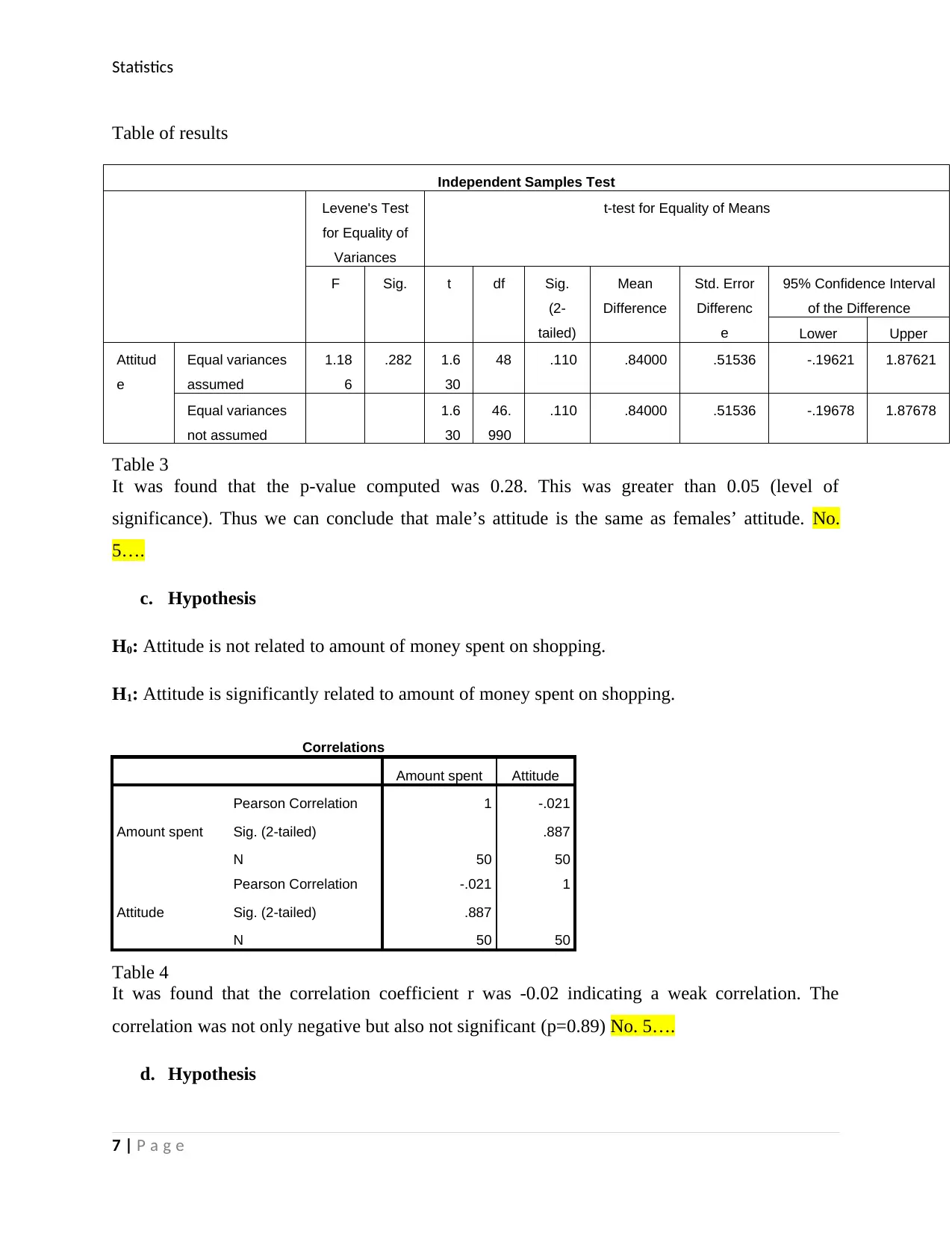
Statistics
Table of results
Independent Samples Test
Levene's Test
for Equality of
Variances
t-test for Equality of Means
F Sig. t df Sig.
(2-
tailed)
Mean
Difference
Std. Error
Differenc
e
95% Confidence Interval
of the Difference
Lower Upper
Attitud
e
Equal variances
assumed
1.18
6
.282 1.6
30
48 .110 .84000 .51536 -.19621 1.87621
Equal variances
not assumed
1.6
30
46.
990
.110 .84000 .51536 -.19678 1.87678
Table 3
It was found that the p-value computed was 0.28. This was greater than 0.05 (level of
significance). Thus we can conclude that male’s attitude is the same as females’ attitude. No.
5….
c. Hypothesis
H0: Attitude is not related to amount of money spent on shopping.
H1: Attitude is significantly related to amount of money spent on shopping.
Correlations
Amount spent Attitude
Amount spent
Pearson Correlation 1 -.021
Sig. (2-tailed) .887
N 50 50
Attitude
Pearson Correlation -.021 1
Sig. (2-tailed) .887
N 50 50
Table 4
It was found that the correlation coefficient r was -0.02 indicating a weak correlation. The
correlation was not only negative but also not significant (p=0.89) No. 5….
d. Hypothesis
7 | P a g e
Table of results
Independent Samples Test
Levene's Test
for Equality of
Variances
t-test for Equality of Means
F Sig. t df Sig.
(2-
tailed)
Mean
Difference
Std. Error
Differenc
e
95% Confidence Interval
of the Difference
Lower Upper
Attitud
e
Equal variances
assumed
1.18
6
.282 1.6
30
48 .110 .84000 .51536 -.19621 1.87621
Equal variances
not assumed
1.6
30
46.
990
.110 .84000 .51536 -.19678 1.87678
Table 3
It was found that the p-value computed was 0.28. This was greater than 0.05 (level of
significance). Thus we can conclude that male’s attitude is the same as females’ attitude. No.
5….
c. Hypothesis
H0: Attitude is not related to amount of money spent on shopping.
H1: Attitude is significantly related to amount of money spent on shopping.
Correlations
Amount spent Attitude
Amount spent
Pearson Correlation 1 -.021
Sig. (2-tailed) .887
N 50 50
Attitude
Pearson Correlation -.021 1
Sig. (2-tailed) .887
N 50 50
Table 4
It was found that the correlation coefficient r was -0.02 indicating a weak correlation. The
correlation was not only negative but also not significant (p=0.89) No. 5….
d. Hypothesis
7 | P a g e
Paraphrase This Document
Need a fresh take? Get an instant paraphrase of this document with our AI Paraphraser
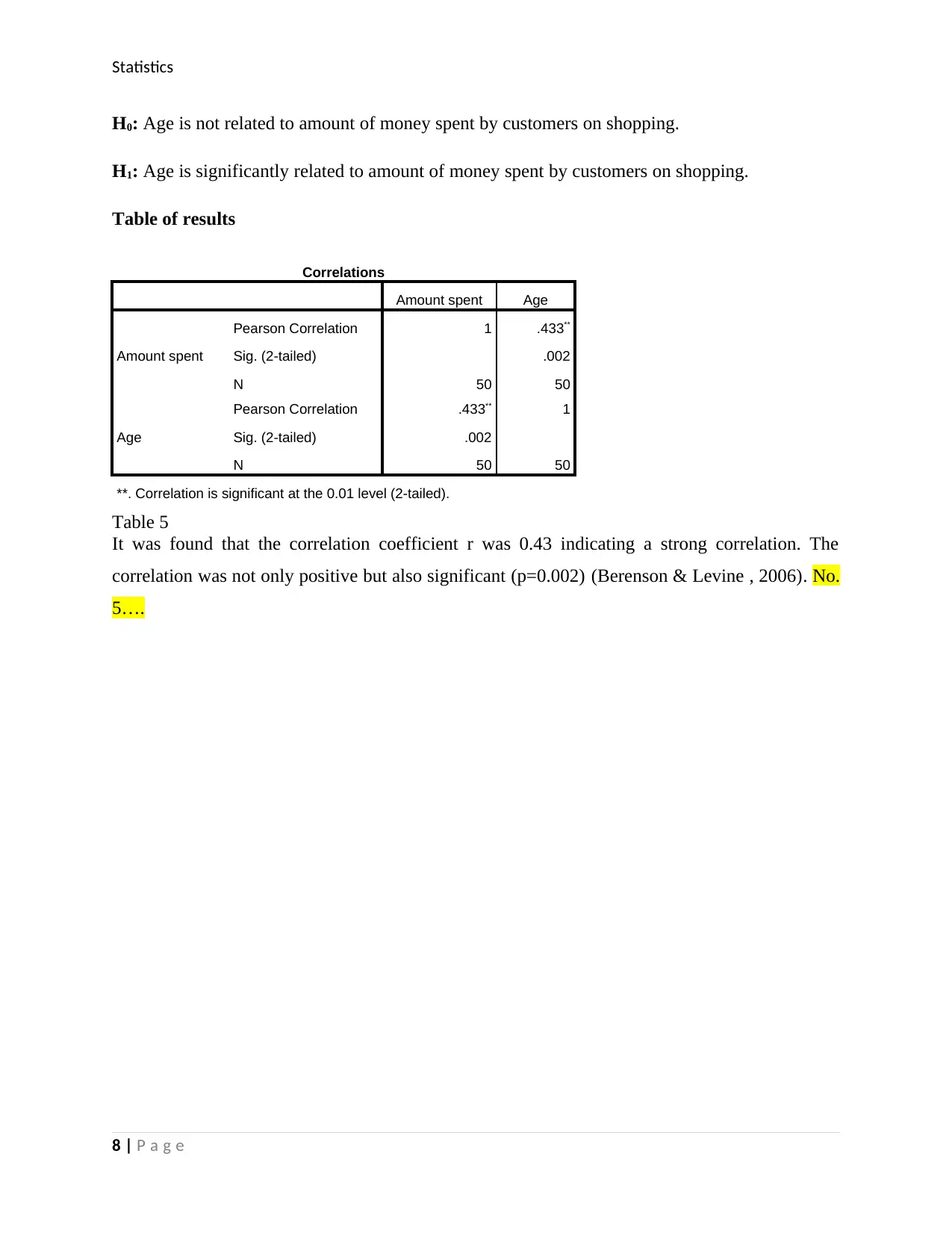
Statistics
H0: Age is not related to amount of money spent by customers on shopping.
H1: Age is significantly related to amount of money spent by customers on shopping.
Table of results
Correlations
Amount spent Age
Amount spent
Pearson Correlation 1 .433**
Sig. (2-tailed) .002
N 50 50
Age
Pearson Correlation .433** 1
Sig. (2-tailed) .002
N 50 50
**. Correlation is significant at the 0.01 level (2-tailed).
Table 5
It was found that the correlation coefficient r was 0.43 indicating a strong correlation. The
correlation was not only positive but also significant (p=0.002) (Berenson & Levine , 2006). No.
5….
8 | P a g e
H0: Age is not related to amount of money spent by customers on shopping.
H1: Age is significantly related to amount of money spent by customers on shopping.
Table of results
Correlations
Amount spent Age
Amount spent
Pearson Correlation 1 .433**
Sig. (2-tailed) .002
N 50 50
Age
Pearson Correlation .433** 1
Sig. (2-tailed) .002
N 50 50
**. Correlation is significant at the 0.01 level (2-tailed).
Table 5
It was found that the correlation coefficient r was 0.43 indicating a strong correlation. The
correlation was not only positive but also significant (p=0.002) (Berenson & Levine , 2006). No.
5….
8 | P a g e

Statistics
References
Statistics for Management and Economics, Duxbury Press, Belmont, CA. (n.d.).
Berenson, M. L., & Levine , D. M. (2006). Basic Business Statistics. New Jersey: Prentice-Hall,
Englewood Cliffs.
Bhattacharyya, G. K., & Johnson , R. A. (2013). Statistical Concepts and Methods. New York:
John Wiley and Sons.
Dixon , W. J., & Massey, F. J. (2009). Introduction to Statistical Analysis. New York: McGraw-
Hill.
Fleiss, J. L., & Paik, M. C. (2003). Statistical Methods for Rates and Proportions, Third Edition,.
New York: John Wiley & Sons.
Hicks, C. R. (2013). Fundamental Concepts in the Design of Experiments. New-York: Rhinehart
and Winston.
9 | P a g e
References
Statistics for Management and Economics, Duxbury Press, Belmont, CA. (n.d.).
Berenson, M. L., & Levine , D. M. (2006). Basic Business Statistics. New Jersey: Prentice-Hall,
Englewood Cliffs.
Bhattacharyya, G. K., & Johnson , R. A. (2013). Statistical Concepts and Methods. New York:
John Wiley and Sons.
Dixon , W. J., & Massey, F. J. (2009). Introduction to Statistical Analysis. New York: McGraw-
Hill.
Fleiss, J. L., & Paik, M. C. (2003). Statistical Methods for Rates and Proportions, Third Edition,.
New York: John Wiley & Sons.
Hicks, C. R. (2013). Fundamental Concepts in the Design of Experiments. New-York: Rhinehart
and Winston.
9 | P a g e
⊘ This is a preview!⊘
Do you want full access?
Subscribe today to unlock all pages.

Trusted by 1+ million students worldwide
1 out of 9
Related Documents
Your All-in-One AI-Powered Toolkit for Academic Success.
+13062052269
info@desklib.com
Available 24*7 on WhatsApp / Email
![[object Object]](/_next/static/media/star-bottom.7253800d.svg)
Unlock your academic potential
Copyright © 2020–2025 A2Z Services. All Rights Reserved. Developed and managed by ZUCOL.





